Excerpts from Jim Conrad's
Naturalist Newsletter
Entry from field notes dated June 30, 2023, from small gravel road along east-facing slope running north from El Socavón about 1 straight-line km SW of El Doctor; in the mountains of east-central Querétaro state, municipality of Cadereyta de Montes, 12 straight-line kms due east of Vizarrón de Montes but much farther by twisting roads; elevation ~2500m (~8200 ft), Querétaro, MÉXICO, (N20.84499°, W99.58179°)
A SPINELESS SPINY CLIFFBRAKE HYBRID, MAYBE

On a roadside limestone ledge the above fern caught my eye because it was somewhat small, with many small blade segments, and curiously colored.
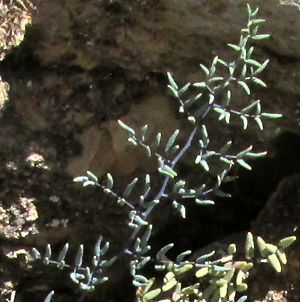
As seen at the right, near the blades' tips the blades were once-divided, or 1-pinnate, but closer to the petiole they became 2-pinnate. The small leaflets, or pinnules, are of varying widths, with the upper ones in the picture being more silvery/bluish than the ones at the lower right, which are more greenish as well as broader. Below is a close-up of pinnules as seen from above:
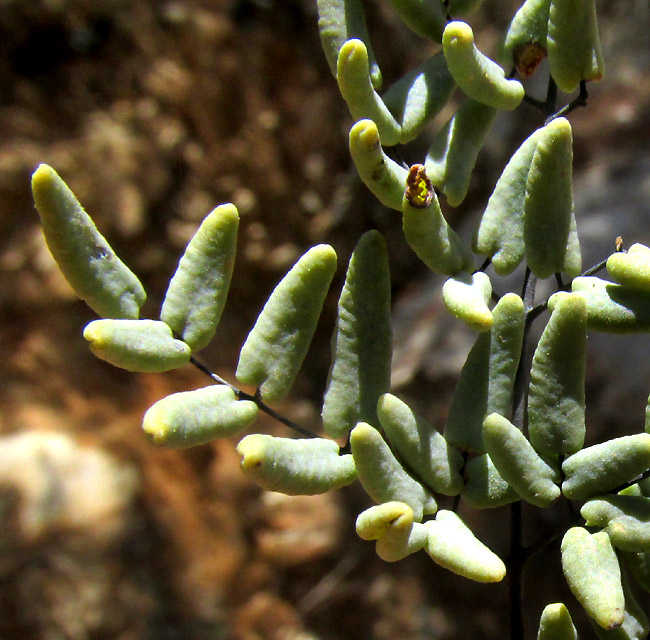
Pinnule bases are downwardly two-lobed and pinnules tend to be slightly curved. Their tips are not conspicuously pointed, though some hint at the tendency to form a hard tip, or mucron. Stalks and stems are wiry and black. Some pinnules, as at the top, right, appear to form closed cylinders. One such closed pinnule has its top nibbled off, revealing grainy, spore-producing sporangia inside.
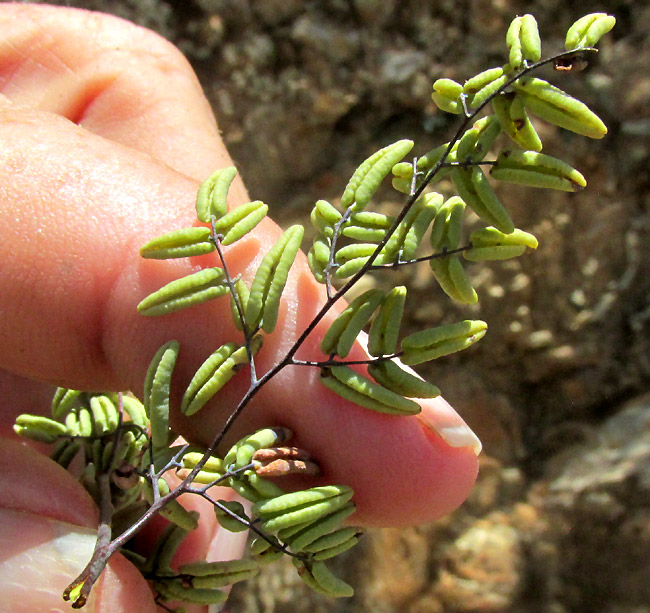
Above, pinnules are shows from below. Toward the picture's base you can better see the 2-pinnate subdivision, divisions of divisions. I'm guessing that the pinnules are hardly open because they're so young.
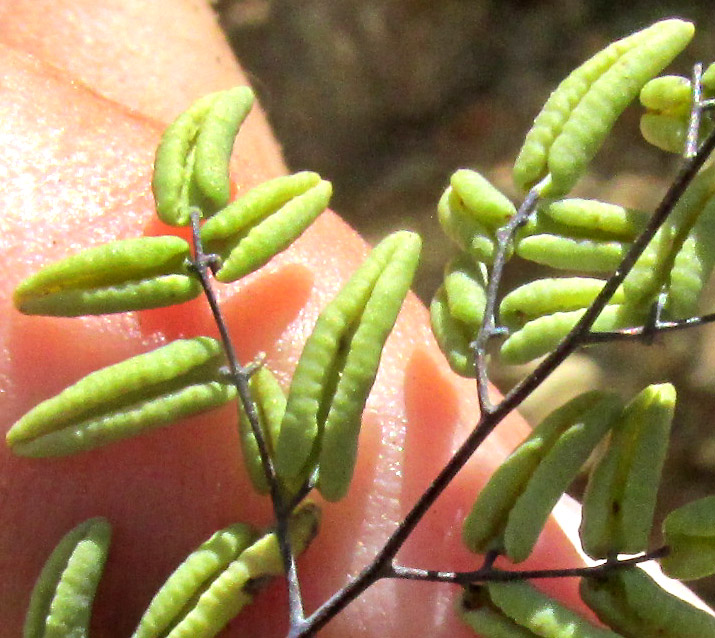
Closer up, it's seen that pinnule margins bear low bumps.
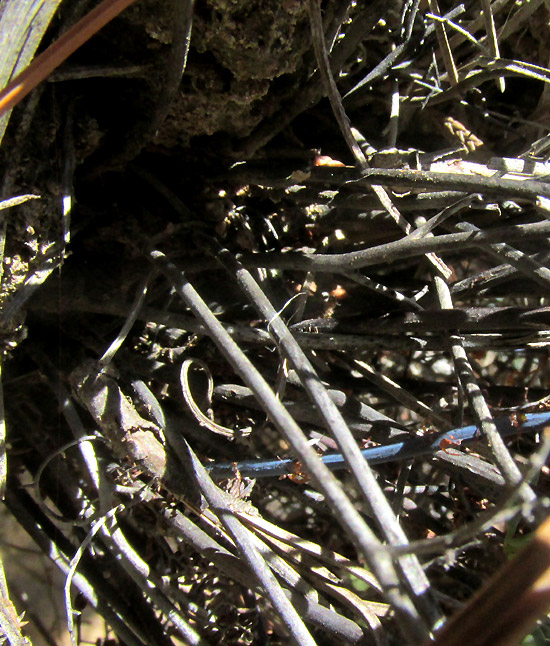
Often fern blade stems, or petioles, bear conspicuous scales, which can be variously colored. Our fern's petioles were mostly without scales, though here and there tiny, isolated flakes could be seen.
This fern is a member of the genus Pellaea, whose species often are called cliffbrakes. Usually cliffbrakes grow in rocky places, especially on slopes and bluffs, like ours. Beyond the genus, I don't know what it is.
It's very similar to the Spiny Cliffbrake, Pellaea truncata, which occurs in this area, but its pinnules don't bear little "spines," or mucros, at their tips. Also, that species has brown stalks and stems, while our fern's are black with a silvery, or glaucous, sheen. Its pinnule bases don't produce such pronounced downward-protruding lobes. Spiny Cliffbrake is described as rarely occurring on limestone, but ours is on limestone.
In the southwestern US and Mexico's Baja California there's the Wright's Cliffbrake, which looks very much like the Spiny Cliffbrake, and a little less like our plant. Interestingly, Wright's Cliffbrakes have for a long time been the subject of disputation and wonder among taxonomists, as described in the 2022 paper by Michael Windham and others aptly entitled "Once more unto the breach, dear friends: Resolving the origins and relationships of the Pellaea wrightiana hybrid complex."
So, the similar-looking Wright's Cliffbrake is a hybrid complex. Specifically, the above paper concludes that "... plants identified as P. wrightiana represent three morphologically distinguishable polyploids that have arisen through repeated hybridization events involving the divergent sexual taxa P. ternifolia and P. truncata."
Polyploids are organisms possessing more than two complete sets of chromosomes, and over half of all plants are polyploids. Polyploidy typically results in instantaneously formed new species, thus is considered a process that greatly increases biodiversity by providing new genetic material for evolution. Sometimes the newly appeared polyploid looks and behaves different from the parent organism, but other times not. It can be a cryptopolyploid.
The above-mentioned study found that Wright's Cliffbrake's polyploidy arose through repeated hybridization involving Pellaea ternifolia and Pellaea truncata. Both of those species occur in our part of upland central Mexico. The Flora of North America page for the Spiny Cliffbrake, Pellaea truncata, remarks that " Morphologically intermediate hybrids between P. truncata and P. wrightiana are common in regions where the ranges of the two species overlap, but these are easily identified by their malformed spores." I can't see individual spores, but the point is that there's a good bit of hybridization among the various cliffbrake species mentioned here, that Pellaea ternifolia and Pellaea truncata, both are found here, they have hybridized before, so maybe that's what we have here.
Our plant could have its black petioles and rachises, and its pinnules' pronounced basal lobes, from Pellaea ternifolia. That species is different from ours, however, because it doesn't develop 2-pinnate subdivisions, and has some deeply 3-lobed pinnae. Where other features of our plant come from, such as its lack of "spines" at its pinnule tips, who knows?
Whatever the case, this is an interesting fern doing its own thing. I wonder if its spores are fertile, and what might be the future of any offspring it might produce.